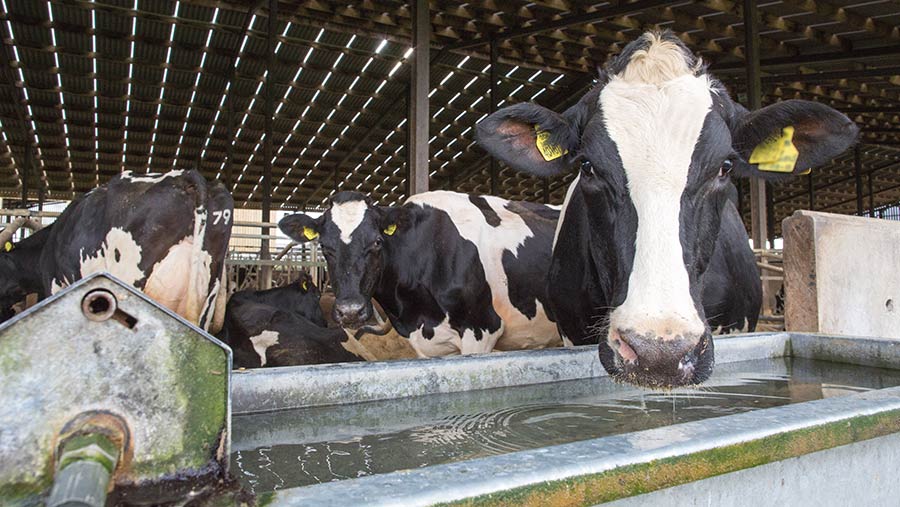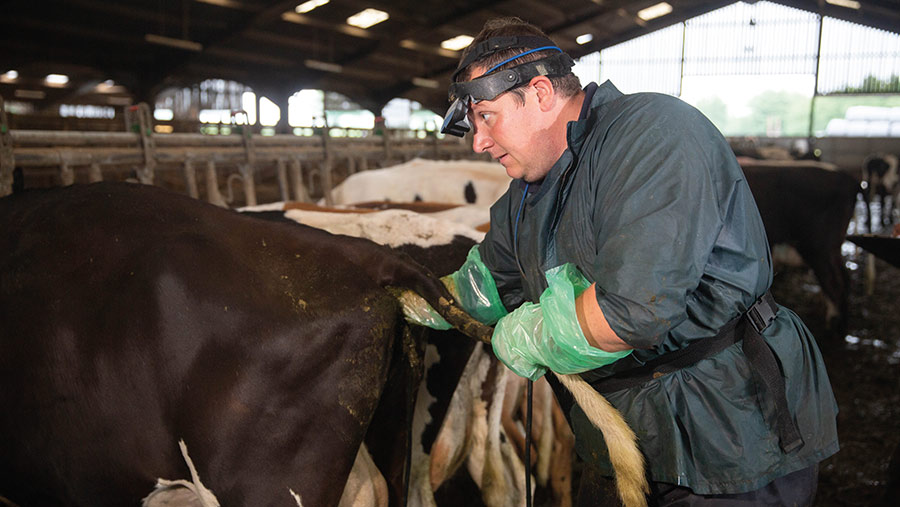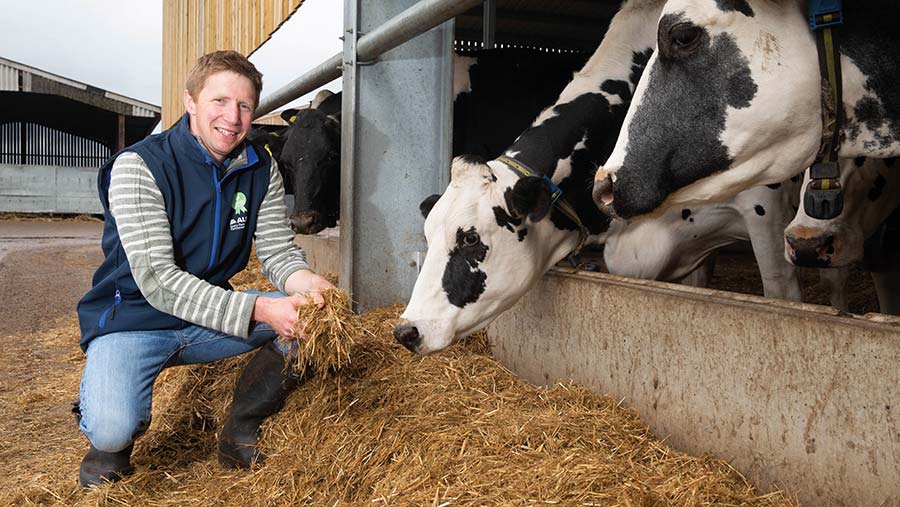4 ways to further improve herd fertility
 © Tim Scrivener
© Tim Scrivener Many farmers could make big improvements to the fertility of their herds by paying greater attention to dry cow management, stable nutrition and routine vet visits.
According to vet Graeme McPherson of Synergy Farm Health, the industry has made huge gains in fertility performance over the past 20 years. He puts this down to wider uptake of automated heat detection systems, breeding for fertility – thanks to the introduction of the Fertility Index in 2005 – improvements in farm infrastructure and better nutrition.
See also: 4 tips to optimise dairy cow fertility
However, data from 500 National Milk Records (NMR)-recorded herds suggests there is still room for improvement on many farms (see “Fertility performance”).
Mr McPherson suggests four key areas farmers should focus on to boost fertility.
1. Dry cow management
Dry cows are the most important group on the farm.
Maximise dry matter intakes before calving by providing a bespoke, palatable diet and enough feed and water space.
Achieving good intakes prior to calving will set cows up to eat well after calving. This will limit metabolic disease and loss of body condition score, which could otherwise adversely affect fertility. Provide 90cm of feed space a cow in the 30 days before calving and at least 10cm of water trough space.
2. Good stable nutrition in the milking cows
Consistency of feeding is essential for good fertility.
Wherever possible, avoid making changes to the diet, as it takes about 10 days for the rumen to adjust to any dietary alterations. Stress should also be limited, so handle animals quietly.
3. Excellent record keeping
Recording service is a “no-brainer”, but all heats should be recorded, even if a cow isn’t eligible for service. For example, if a cow bulls at 35 days and the voluntary waiting period (VWP) is 50 days, recording this information allows for predictions to be made about when she will come bulling again.
Monitoring body condition score (BCS) at calving, the end of the VWP, mid-lactation and drying-off allows for changes to be tracked.
A cow that loses more than half a BCS after calving is less likely to get pregnant. This is not just about condition loss, but the speed of that loss, as this will compromise egg quality and delay resumption of cycling.
Fat cows are more likely to lose condition; ensuring all cows are at BCS 2.75-3.25 will reduce the risk of weight loss.
4. Routine vet visits
One of the pillars of good fertility is pregnancy diagnosis (PD). Early PD will allow quick identification of any cows that are not in-calf so they can be flagged up
as needing to be served again.
Any cow that has not been seen bulling within a certain number of days, depending on the farm, may need to be checked by the vet. This could be, for example, any cow not seen bulling 21 days after the VWP.
Fertility performance

© Tim Scrivener
Results from a University of Reading herd performance study of 500 Holstein/Friesian NMR-recorded herds for the year to August 2020, showed:
400 days
Median (middle herd) calving intervals in 2020. This has remained at a similar level since 2018, following a steady reduction from 424 days in 2010
35%
Median conception rate in 2020, unchanged since 2018
29% or less
Conception rate of one herd in four
+ Heat detection rate has steadily improved since 2010
40%
Median submission rate – a 13% increase compared to 27% in 2010, but only a 2% improvement on the 2016 rate
14%
Median pregnancy rate in 2020, an increase from 9% in 2010, but relatively unchanged since 2017
Targets
Although performance targets should be farm specific, vet Graeme McPherson suggests the following:
Year-round-calving herds
- More than 25% pregnancy rate
- More than 40% conception rate
- More than 65% submission rate
- Less than 400-day calving interval (ideally 385 days in a Holstein herd)
Block-calving herds
- 30-40% pregnancy rate
- 365-day calving interval
Case study: Mark Larwood, Oak House Farm, Larling, Norfolk

© Tim Scrivener
Farm facts
- 250ha (617 acres)
- 250 Holsteins calving all year round with strong autumn bias
- 10,450 litres a cow a year at 4.3% fat and 3.32% protein
- Milked twice a day
- 70% calve August to Christmas with all replacements (75) taken in this period
- Heifers and first and second calvers served twice to sexed semen; the rest served to Limousin
- Heifers served twice to sexed semen and then Aberdeen Angus
Fertility performance at Oak House Farm for 12 months ending October 2021
Cows
- 31.5% pregnancy rate
- 69% submission rate
- 45% conception rate
- 57% 100 day in-calf rate
- 1.81 services/conception
- 374 days calving interval
Heifers
- 47% pregnancy rate
- 1.56 services/conception
Good teamwork is one reason for average pregnancy rates of 31.5% and a 100-day in-calf rate of 57% at Mark Larwood’s dairy farm.
The 2021 Farmers Weekly Dairy Farmer of the Year cites four further factors helping the fertility performance of his herd.
Automated heat detection
Mr Larwood believes the use of automated heat detection on cows and heifers has been crucial in achieving high levels of performance.
Cows have automated heat-detection collars with rumination sensors, while heifers have heat-detection ear tags. This has taken pressure off staff, who previously had to observe cows for two hours a day.
Prior to installation, heifers were achieving conception rates of 57%. This increased to 68% in 2020 after the system was up and running. Mr Larwood says this is because each animal they serve is definitely bulling.
Transition cow management
“I believe it’s possible to get good fertility in high-yielding cows, it’s just about consistency day to day and, if you’ve got a bottleneck in your system, sorting that out. For us that was our transition cow shed,” he says.
In the autumn of 2020, he invested in a new, more spacious transition cow building. Lying space has increased from 6sq m a cow to 11sq m a cow. Feed space has risen by about 10%, improving dry matter (DM) intakes.
As a result, the level of retained foetal membranes has dropped from 11% to 5%, and just 1% of animals get milk fever.
“If those cows are clean and cycling well, they’ll get in-calf,” says Mr Larwood, who feeds transition cows a consistent partial dietary cation anion balance diet. This helps transition cows mobilise calcium and reduces the risk of milk fever.
Any cows that show a drop in rumination rates and, therefore, a drop in DM intake after calving will also have their temperature checked daily.
Vet checks
The farm has a voluntary waiting period of 45 days. Any cow not seen bulling or served by 60-67 days after calving will be presented to the vet for checking or enrolment onto hormonal synchronisation.
About 10-15% of cows go onto hormonal protocol OvSynch. The farm also runs a weekly pregnancy diagnosis session.
Health status
The closed herd has accredited bovine viral diarrhoea-free status. It is also free of infectious bovine rhinotracheitis and leptospirosis, and has no cows with Johne’s disease.
